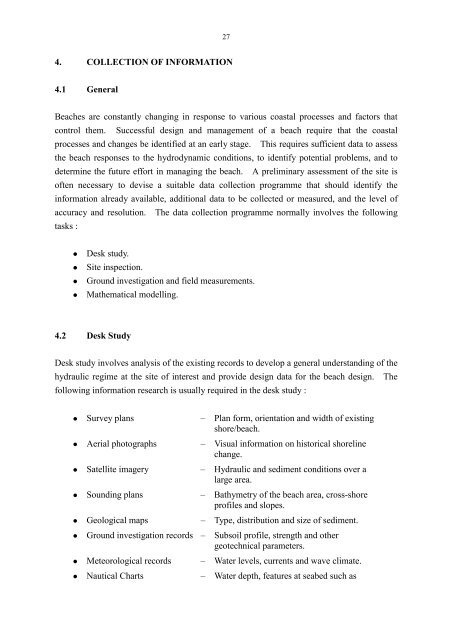PORT WORKS DESIGN MANUAL PART 5 Guide to Design of ...
PORT WORKS DESIGN MANUAL PART 5 Guide to Design of ...
PORT WORKS DESIGN MANUAL PART 5 Guide to Design of ...
Create successful ePaper yourself
Turn your PDF publications into a flip-book with our unique Google optimized e-Paper software.
27<br />
4. COLLECTION OF INFORMATION<br />
4.1 General<br />
Beaches are constantly changing in response <strong>to</strong> various coastal processes and fac<strong>to</strong>rs that<br />
control them. Successful design and management <strong>of</strong> a beach require that the coastal<br />
processes and changes be identified at an early stage. This requires sufficient data <strong>to</strong> assess<br />
the beach responses <strong>to</strong> the hydrodynamic conditions, <strong>to</strong> identify potential problems, and <strong>to</strong><br />
determine the future effort in managing the beach. A preliminary assessment <strong>of</strong> the site is<br />
<strong>of</strong>ten necessary <strong>to</strong> devise a suitable data collection programme that should identify the<br />
information already available, additional data <strong>to</strong> be collected or measured, and the level <strong>of</strong><br />
accuracy and resolution. The data collection programme normally involves the following<br />
tasks :<br />
• Desk study.<br />
• Site inspection.<br />
• Ground investigation and field measurements.<br />
• Mathematical modelling.<br />
4.2 Desk Study<br />
Desk study involves analysis <strong>of</strong> the existing records <strong>to</strong> develop a general understanding <strong>of</strong> the<br />
hydraulic regime at the site <strong>of</strong> interest and provide design data for the beach design. The<br />
following information research is usually required in the desk study :<br />
• Survey plans – Plan form, orientation and width <strong>of</strong> existing<br />
shore/beach.<br />
• Aerial pho<strong>to</strong>graphs – Visual information on his<strong>to</strong>rical shoreline<br />
change.<br />
• Satellite imagery – Hydraulic and sediment conditions over a<br />
large area.<br />
• Sounding plans – Bathymetry <strong>of</strong> the beach area, cross-shore<br />
pr<strong>of</strong>iles and slopes.<br />
• Geological maps – Type, distribution and size <strong>of</strong> sediment.<br />
• Ground investigation records – Subsoil pr<strong>of</strong>ile, strength and other<br />
geotechnical parameters.<br />
• Meteorological records – Water levels, currents and wave climate.<br />
• Nautical Charts – Water depth, features at seabed such as

















